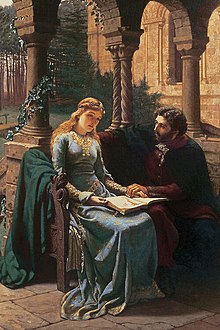Romantic fantasy
Romantic fantasy is a subgenre of fantasy fiction, describing a fantasy story using many of the elements and conventions of the romance genre.[1]

One of the key features of romantic fantasy involves the focus on relationships, social, political, and romantic.[2] Romantic fantasy has been published by both fantasy lines and romance lines.
Some publishers distinguish between "romantic fantasy" where the romance is most important and "fantasy romance" where the fantasy elements are most important.[1] Others say that "the borderline between fantasy romance and romantic fantasy has essentially ceased to exist, or if it's still there, it's moving back and forth constantly".[3]
Magic in romantic fantasy
"Attitudes toward magic in Romantic Fantasy are usually very different from that expressed in most high fantasy or sword and sorcery. Rather than representing an alien and corrupting force that destroys its practitioners, or a complex, secretive body of folklore that isolates magicians from normal society via long study and seclusion, magic typically takes the form of innate abilities that are natural and simple to use, sometimes described as psychic talents like empathy or precognition, sometimes oriented towards affinity for or control of a particular natural element (such as the four classical Greek elements, fire, air, earth and water). Magic is thus presented in the narrative as an innate and positive part of someone's nature, and by extension a "natural" part of the world; fear of these abilities is often depicted as a reaction born of ignorance, poor guidance, or evil."[2]
Common plot archetypes
- A teenager, typically either from an overly strict or abusive family (or alternately from a family or a village that has been slain by bandits or monsters) runs away and discovers that they possess either magical or psychic powers and a glorious destiny. This destiny often involves saving a city, kingdom, or other large group from harm by a powerful villain or a dangerous monster.
- A somewhat older person, often a minor noble or someone who has recently lost a loved one and has left their previous home in search of a new life (this character is also frequently a magician or psychic) either overthrows an usurper or saves their kingdom from outside invasion. Such characters are rarely warriors, and normally uncover the plot through a combination of intrigue, luck, and use of their powers. In the course of this adventure, the character typically falls in love and, by the end of the novel or at least by the end of the series, their lover becomes their life-partner. The complexities of this romance form a significant focus in these novels.
- In a time of troubles, a group of adolescents or adults are drawn together through circumstance and destiny to form a group or organization that is larger than the sum of its parts. Generally, these young people are outcasts, orphans, or people on the fringes of society. Most or all of these people also possess some form of special powers. The groups' special powers sometimes form a complementary set, such as a group comprising four people each of whom has the ability to command one of the four classical elements. These characters eventually find friendship, community, and sometimes love with the others in their newly formed group. This group frequently ends up either overthrowing the current social order (often to restore it to the realm's previous idyllic state) or overcoming some threat that no one else is aware of or able to face.
Character development
Characters may start as solitary wanderers in romantic fantasy, but they never remain that way for long. One of the key features of romantic fantasy involves the focus on social, and to a lesser extent, political relationships. The characters all find close friends, lovers, and other companions with whom they either live or travel, as well as a larger social circle where they all belong. In addition, many character have significant ties with the larger world. Many of these characters have noble titles, or a sworn duty to their kingdom. The rootless travelers of sword and sorcery novels are rarely found in romantic fantasy.
"Romantic Fantasy protagonists do often begin their journey by escaping an abusive or oppressive environment, but their goal is not to become free from all social ties. Instead, most characters are looking for a new community or social group where they truly belong. Being part of a supportive social group is considered far superior to being even the most independent and competent loner. Finding (or on occasion helping to create) a new social group where the character fits in and is happy is considered much better than attempting to force their previous group to change -- significant changes of opinion and practice are argued to be more beneficial and effective if they happen gradually, and develop from within rather than being imposed. While it often remains necessary for enemies to be defeated by direct violent confrontation, diplomatic resolution of conflict is considered superior to raw force; many stories contain, in addition to the primary (and usually most explicitly "evil" antagonist) a subsidiary or secondary antagonist with more sympathetic motivations, and who is eventually converted to an ally through negotiation and diplomacy."[2]
Examples of romantic fantasy in literature
- Catherine Asaro's Lost Continent series;[4] The Charmed Sphere, The Misted Cliffs, The Dawn Star, The Fire Opal, The Night Bird.
- Mercedes Lackey's Five Hundred Kingdoms series;[5] Fairy Godmother, One Good Knight, Fortune's Fool (novel).
- Tamora Pierce's The Immortals quartet;[citation needed] Wild Magic, Wolf-Speaker, Emperor Mage, The Realms of the Gods.
- Wen Spencer's Tinker series; Tinker,[6] Wolf Who Rules.
See also
References
- ^ a b William C. Robinson (October 2004). "A Few Thoughts on the Fantasy Genre". University of Tennessee, Knoxville. Retrieved 18 January 2009.
- ^ a b c John Snead. "What is Romantic Fantasy?". Green Ronin Publishing. Retrieved 18 January 2009.
- ^ Fantasy Reviews
- ^ Reader's Advice
- ^ Auburn Hills Public Library - Booklist
- ^ Tinker at Amazon.com
